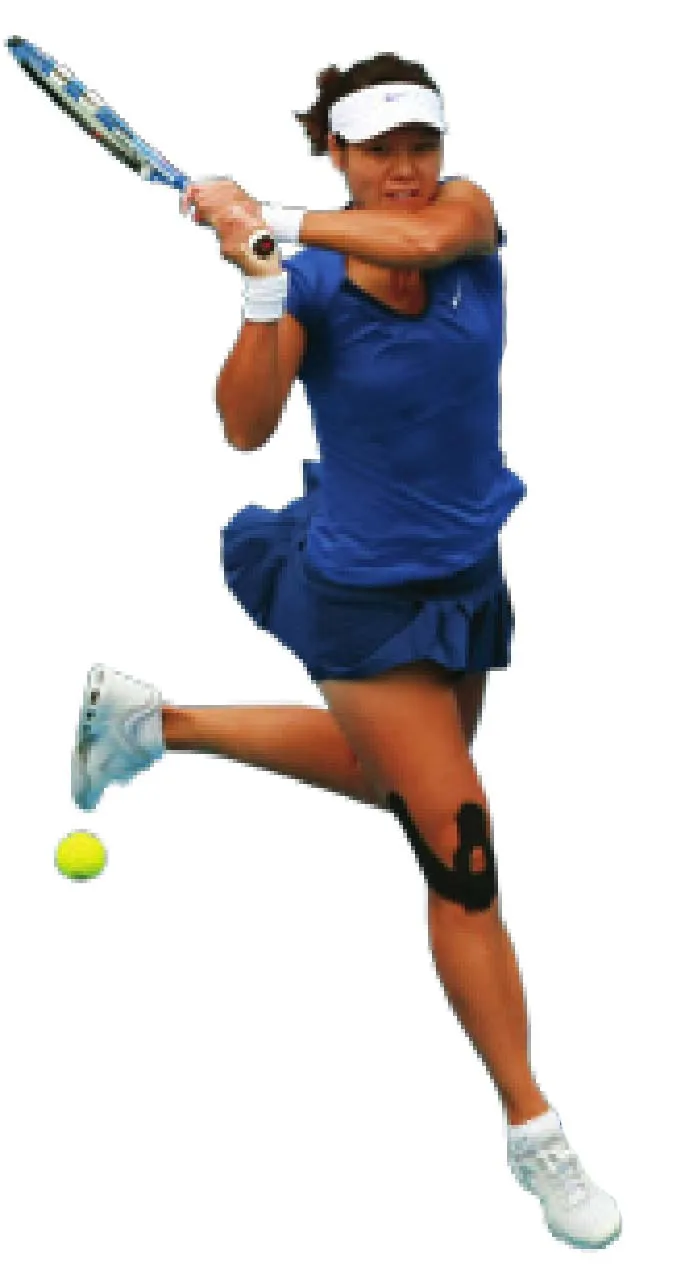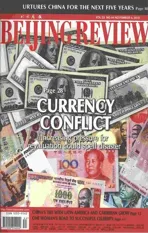A Rising Sport
2010-10-14ByYINPUMIN
By YIN PUMIN
A Rising Sport
By YIN PUMIN
Tennis is becoming more popular in China but there are still worries facing the sport
October was a happy time for the sport of tennis and tennis fans in China.The China Open in Beijing, the 2010 Shanghai Rolex Masters and the China Tennis Grand Prix in Nanjing, Jiangsu Province, all take place.
After football and basketball and even boxing, golf, rugby, snooker and cricket,tennis has also got in the queue of vigorous competition for attention in the marketplace.
As an emerging tennis market, China is now drawing the attention of the entire tennis world thanks to its large potential and rising players in the sport, said Stacey Allaster,Chairman of the Sony Ericsson Women’s Tennis Association (WTA) Tour.
At present, China has two WTA tournaments each year—the Guangzhou Open and the top-level China Open in Beijing. An Association of Tennis Professionals (ATP)Masters event is also held in Shanghai.
The China Open enjoyed unprecedented success this year. Organizers claimed that all tickets to the event, which was held from September 25 to October 11 at the Lotus Court of the National Tennis Center, were sold out by the second day of the competition.
Upgraded to one of the four Crown-Jewel WTA tournaments, the top tier of the tour last year, the China Open has become the most important event before the seasonending championship in Doha, Qatar. The winner in Beijing claims 1,000 points and a mammoth $4 million and improves her chances of capturing the No.1 crown at the end of the season. The men’s competition has risen from a $500,000 to a $2 million ATP 500 event.
The event also provided a grand opportunity for Chinese fans to see more top world players and their high-level competitions.
During the China Open, fans witnessed Caroline Wozniacki become the first Danish tennis player to be crowned world No.1 when she beat Czech Petra Kvitova to reach the quarter-finals on October 7.
The Danish girl also outlasted Russian Vera Zvonareva on October 11 to be the champion of the China open.
On the men’s side, 23-year-old Serbian Novak Djokovic, world No.2 tennis player,was unstoppable in claiming his second China Open title with a victory on Spanish No.8 seed David Ferrer.
The 2010 Shanghai Rolex Masters, an ATP 1000 event, attracted most world top players. Besides the former world No.1 Roger Federer from Switzerland, the top players also included Spanish world No.1 Rafael Nadal, Serbian world No.2 Djokovic,Robin Soderling of Sweden and world No.4 Andy Murray of Britain.
A booming market
The breakout moment for Chinese tennis came in 2004 when a hitherto unknown Chinese duo Li Ting and Sun Tiantian struck doubles gold at the Athens Olympics.
After that, more Chinese tennis players have alternated in setting new standards for the country.
After two years at university, Li Na became the first Chinese player to win an event on the WTA circuit, the first ranked in the top 20 and the first to reach a Grand Slam quarter-final at Wimbledon in 2006.
In 2006, more tennis history was written when Zheng Jie and Yan Zi won doubles at the Australian Open and Wimbledon. At Wimbledon in 2008, Zheng became the first Chinese player ever to reach the semifinals of a Grand Slam singles tournament, and in 2009, became the fi rst Chinese player to be ranked in the world’s top 15.

PLAYING ON STAGE: The 21-year-old Chinese tennis player Bai Yan hits the ball in a match during the 2010 Shanghai Rolex Masters on October 8

FACE OF CHINA: Li Na of China returns the ball during the women’s singles quarterfinal match against Anastasija Sevastonva of Latvia at the China Open tennis tournament in Beijing on October 8

CRAZY FANS: Enthusiastic aud ience w aits fo r tennis stars to sign au tog raphs du ring the 2010 China Open on Oc tober 11
During the 2010 Australian Open in January, Li and Zheng made history, becoming the first two Chinese players to reach the top four of a Grand Slam tournament simultaneously and Li then became the fi rst Chinese player to break into the world top 10 and she managed to reach No.9 in the world rankings in August.
“Li’s reaching of the world’s top 10 is a m ilestone in China’s tennis history and provides great encouragement to other Chinese players,” said Sun Jinfang, Deputy Director of the Chinese Tennis Association (CTA).“The grow th of the tennis population is the foundation of the sport’s popularity and also a priority for the CTA.”
According to the WTA Tour, China has 30,000 tennis courts and an estimated 14 million people in China regularly play tennis,up from 1 million when the sport returned to the Olympics in 1988.
“More than 100 tennis tournaments for amateur players have also boosted the popularity of the sport here,” she said.
During those competitions, tennis carnivals are also held for the general public to enjoy the sport.
“We hope with the platform of those carnivals, tennis w ill become even more and more popular at the grassroots level,”Chinese tennis chief Sun said.
Besides, many other activities are also held each year to popularize the sport among the public.
The Sw ing for the Stars program is a junior tennis development program in 2008. It offers comprehensive support in promoting the development of tennis in China and aims to cultivate future stars.
A fter years of toiling in obscurity,China’s male tennis players may finally be grabbing a toehold on the ATP circuit.
At the 2010 Shanghai Rolex Masters,w ild card Bai Yan, the 21-year-old world No.465, dism issed Czech veteran Radek Stepanek, a former world top-10 player,in his ATP main draw debut on October 12, heralding a major breakthrough for China’s male players on the international stage.
Men’s g row th
A few hours after Bai’s unexpected victory, another Chinese youngster, Zhang Ze,the world No.308, almost caused another major upset when he pushed former world No.3 Ivan Ljubicic to three sets before losing 5-7, 6-3, 6-4.
Even to diehards of Chinese tennis, the names of the country’s top male tennis players are unfamiliar. A bunch of 20-something young aces including Zhang and Bai still have a long way to go due to a lack of experience in high-level tournaments.
“I think the male players in China are still at the beginner’s stage. None of us has experienced many high-level matches in big tournaments,” Bai said after returning to reality when Murray defeated him in a quick second-round match.
Keen to play at high-level tournaments,but hamstrung by their rankings, China’s aces are trapped in a dilemma.
Sun said the CTA is trying to hold more games to provide a proper stage for Chinese players to reach the world’s top level.
“There a re m o re than 10 ATP Challengers on our players’ schedule this year, it is a valuable opportunity to feel the pressure in close matches against opponents w ithin the top 200-300 and to gain more points than from the International Tennis Federation (ITF) Futures,” Lu Ling,the men’s national team’s head coach, said in Nanjing on October 14 during the 2010 Mercedes-Benz China Tennis Grand Prix.
“Obviously, it’s much harder for the men to catch up to the rest of the world than the w omen. But a bunch of young guys around the top 400 show great potential,” said Tomas Hogstedt, coach of Li Na. “What they need is patience and confidence.”
A lthough Chinese tennis has achieved great progress in recent years, there are still many worries for the officials and players.
Apart from Li and Zheng and another veteran, Peng Shuai, the world No.61, there are only two other Chinese players ranked in the world top 200—21-year-old Zhang Shuai at No.83 and 20-year-old Han Xinyun at No.145.
During this year’s China Open, only Li saved some face for the hosts, but younger Chinese players failed to step forward. Ten of 11 young Chinese women players failed to win a match in Open qualification and all failed to enter the main draw.
During a news conference on October 6,Sun openly lambasted the new generation of women’s players by describing them as the “affluent second generation,” which negatively refers to young people born into wealthy families in China.
“They have been provided w ith better training facilities and conditions than the senior players. But I do not think they fully recognize the significance of their play, especially in big events,” Sun said.
Zhang Shuai, once seen as a tennis prodigy, said the burden of high expectations might be the reason behind the lackluster performances of the young Chinese at major events.
System obstac le
Han said a lack of flexibility in choosing competitions was another negative factor.
“According to the sports system, we have to decide which competitions to play at the beginning of a season and cannot change it despite our physical condition at different times,” said Han. “I w ill be more careful when I choose next year’s events.”
Today, the CTA is still using the statesupport system to train its young athletes.Under the system, the young players are managed by the CTA and cannot have private training and competition schedules to support their individual needs and physical conditions.
In late 2002, Li quit Chinese tennis for about a year partly because she felt the training was too regimented and outdated.
In December 2008, the nation’s top four women’s players, Li, Zheng, Peng and Yan, became the fi rst Chinese athletes to be granted unprecedented freedom in managing their careers.
It means they can select their own schedules, coaches and backup teams, and do not have to hand over a significant portion of their prize money to the CTA.
The move initially raised doubts about whether the players would survive on the WTA tour, but Li and Zheng, in particular,have thrived.
Li said, “I believe more and more Chinese players w ill come through and find their rightful place in the tennis world.”
